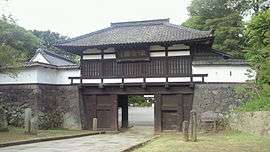Komoro, Nagano
Komoro (小諸市, Komoro-shi) is a city located in Nagano Prefecture, Japan. As of 1 March 2019, the city had an estimated population of 42,489 in 18776 households,[2] and a population density of 430 persons per km². Its total area is 98.55 square kilometres (38.05 sq mi).
Komoro 小諸市 | |
|---|---|
 Komoro City Hall | |
 Flag  Emblem | |
 Location of Komoro in Nagano Prefecture | |
 Komoro | |
| Coordinates: 36°19′36.6″N 138°26′33.5″E | |
| Country | Japan |
| Region | Chūbu (Kōshin'etsu) |
| Prefecture | Nagano |
| Area | |
| • Total | 98.55 km2 (38.05 sq mi) |
| Population (March 2019) | |
| • Total | 42,489 |
| • Density | 430/km2 (1,100/sq mi) |
| Time zone | UTC+9 (Japan Standard Time) |
| Symbols | |
| • Tree | Prunus mume |
| • Flower | Viola mandshurica f.plena[1] |
| Phone number | 0267-22-1700 |
| Address | 3-3-3 Aioi-chō, Komoro-shi, Nagano-ken 384-8501 |
| Website | Official website |

Geography
Komoro is located in eastern Nagano Prefecture. The Chikuma River flows thorough the southern and western part of the city. Some extinct volcanic mountains are located between Komoro and neighboring Tsumagoi. The highest point in Komoro is Mt. Kurofu (ja). Its peak is 2,404 metres (7,887 ft) above sea level. The lowest point is 540 metres (1,770 ft). The old city center is at about 700 metres (2,300 ft). There are many slopes, so Komoro is known as a "hilly city" (坂の町).
Surrounding municipalities
- Nagano Prefecture
- Gunma Prefecture
Demographics
Per Japanese census data,[3] the population of Komoro peaked at around the year 2000 and has declined slightly since.
| Year | Pop. | ±% |
|---|---|---|
| 1940 | 29,706 | — |
| 1950 | 37,701 | +26.9% |
| 1960 | 39,283 | +4.2% |
| 1970 | 39,093 | −0.5% |
| 1980 | 42,355 | +8.3% |
| 1990 | 44,888 | +6.0% |
| 2000 | 46,158 | +2.8% |
| 2010 | 44,012 | −4.6% |
Climate
Komoro is far from the sea and surrounded by mountains, so the rainfall is lower and diurnal temperature range is greater than many locations in Japan, and average annual temperature of Komoro is relatively cool because of the high altitude.[4] The city has a climate characterized by characterized by hot and humid summers, and relatively mild winters (Köppen climate classification Cfa). The average annual temperature in Komoro is 10.8 °C. The average annual rainfall is 1108 mm with September as the wettest month. The temperatures are highest on average in August, at around 23.9 °C, and lowest in January, at around -1.7 °C.[5]
History
Pre-modern
The area of present-day Komoro was part of ancient Shinano Province. The Tōsandō, one of the national routes passed Komoro, which was the location of an Umaya (駅), or post station for government officials and army. However, the name "Komoro" first appears in written history in the Kamakura period chronicle, Azuma Kagami. In these days, Komoro Tarō Mitsukane (小諸太郎光兼), a gokenin assigned by the shogunate to govern the area. During the Muromachi period, the region came under the control of the Ogasawara Ōi clan. The area had a very unsettled history during the Sengoku period. Under the Edo period Tokugawa shogunate, much of the area was under the control of Komoro Domain and the town developed into a jōkamachi around Komoro Castle.
Meiji period and later
The modern town of Komoro was established on April 1, 1889 with the establishment of the Meiji period municipalities system. The town of Komoro annexed villages of Kawabe, Kitaoi and Osato (all from Kitasaku District) on February 1, 1954. The city of Komoro was established on April 1, 1954 after absorbing the villages of Minamioi and Mitsuoka (both from Kitasaku District). On April 1, 1959 parts of the town of Tobu (now part of the city of Tomi) was merged into Komoro and the city has been unchanged since.
Government
Komoro has a mayor-council form of government with a directly elected mayor and a unicameral city legislature of 19 members.
Economy
Komoro is s regional commercial center and has a primarily agricultural economy based on cultivation of rice, vegetables and fruits.[6] Among agricultural products in Komoro, potatoes, soba, apples, and peaches are popular. Komoro has many soba restaurants and apple orchards, so a lot of visitors come there from Shutoken. Komoro is also known for its miso.
Education
Komoro has six public elementary schools and two public middle schools operated by the city government. There are two public high schools operated by the Nagano Prefectural Board of Education.
Transportation
Railway
.svg.png)
- Misato - Mitsuoka - Otome - Higashi-Komoro - Komoro

- Nunobiki Electric Railway (ja) (abolished in 1936)
- Nunobiki - Oshidashi - Hanakawa - Komoro
Sister city relations
Komoro is twinned with:



Local attractions
- Kaikoen, a park in the center of Komoro containing the foundations of Komoro Castle as well as a museum dedicated to Shimazaki Toson (see below) and a zoo(ja). The third gate of castle (San'nomon) and the fourth gate (Otemon) are Important Cultural Properties of Japan, as is the Kyu Komoro Honjin (ja). Kaikoen is known for cherry blossoms, and has been selected as one of the Top 100 Cherry Blossom Viewing Sites in Japan(ja).
- Nunobikisan Shakuson-ji (Nunobiki-Kan'non) (ja), a Buddhist temple dating from 748 AD (Nara period) located at the top of a deep ravine. Kan'nondo Kūden, the oldest surviving building was built in 1252 and is an Important Cultural Property.[7] You can also see Shidare zakura (ja) in April.[8]
- Mountain hiking in Takamine (ja), close to the active volcano Mt Asama, and Mt.Kurofu is about a 30-minute drive uphill from Komoro. You can also enjoy skiing in winter, and Onsen in all seasons there.
- Teranouchi Stone Age Settlement ruins, a Jōmon-period settlement trace and National Historic Site
Notable residents
- Shimazaki Toson, poet and writer. Toson spent a period teaching in Komoro, and is featured in a dedicated museum located within Komoro's Kaikoen park.
- Sodo Yokoyama, a leaf-flute Zen Master who lived as a hermit in Komoro's Kaikoen Park until 1980. Yokoyama was inspired by an earlier resident of Komoro, the poet and writer Shimazaki Toson. See Arthur Braverman's excellent article for some personal recollections of Yokoyama.
- Shuichi Abe, the current governor of Nagano prefecture. He and his family have been living in Komoro since 2014.[9]
References
- From Shinshû, The foot of Mt.Asama (Komoro Sumire) (in japanese)
- Komoro City official statistics (in Japanese)
- Komoro population statistics
- city website Environment White Paper 2017 (in japanese)
- Komoro climate data
- Campbell, Allen; Nobel, David S (1993). Japan: An Illustrated Encyclopedia. Kodansha. p. 822. ISBN 406205938X.
- さわやか信州旅.net 釈尊寺観音堂宮殿 By Nagano Tourism Organization (in Japanese)
- さわやか信州旅.net 布引観音の桜 By Nagano Tourism Organization(in Japanese)
- The talk with governor Abe | Community Television Komoro(in japanese)
External links
| Wikimedia Commons has media related to Komoro, Nagano. |
- Official Website (in Japanese)
- Komoro Tourism Website (in Japanese)
- 「小諸で待ってる」(Promotional Video by Komoro Tourism Bureau)(added English subtitles)